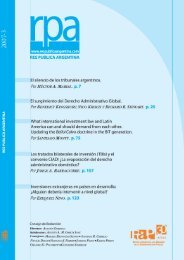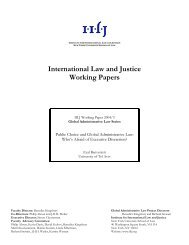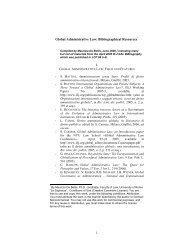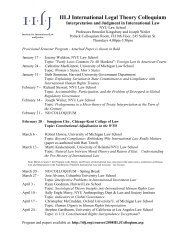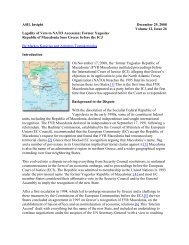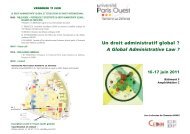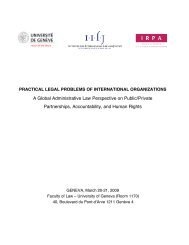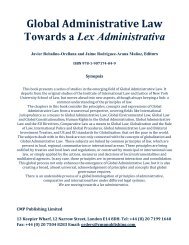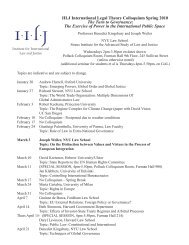作为治理形式的国际投资仲裁:公平与公正待遇、比例原则与新兴 ... - IILJ
作为治理形式的国际投资仲裁:公平与公正待遇、比例原则与新兴 ... - IILJ
作为治理形式的国际投资仲裁:公平与公正待遇、比例原则与新兴 ... - IILJ
Create successful ePaper yourself
Turn your PDF publications into a flip-book with our unique Google optimized e-Paper software.
转到东道国,而且包括秘密或突然干预式的动用权利人财产,使所有权人无法对其全部<br />
或大部分财产予以使用,以及对合理预期的经济利益的剥夺,而前述措施并不要求东道<br />
国会明显获利”。 127<br />
传统的习惯国际法与条约法理论认为:直接征收与间接征收在国际投资条约下的唯一<br />
合法依据就是公共目的,而且必须以非歧视的方式实施并遵循正当法律程序。最为重要的是,<br />
直接征收与间接征收通常都要求补偿。 128<br />
东道国的监管行为也可能导致间接征收的发生。在仲裁判例中,对于如何区分需要补<br />
偿的征收与无需补偿的财产监管行为,不同的仲裁庭采用的基本方法也不同。 129 一些仲裁庭<br />
仅仅考虑东道国措施的影响,从而认为一项间接征收需要获得补偿是因为该措施的影响达到<br />
了一定强度,其要么对财产权利的重要部分施加了的永久干预, 130 要么对相关财产价值造成<br />
了实质性的减少或损害。 131 然而,在决定一项普通措施是否使得投资者有权根据间接征收的<br />
概念要求补偿时,大多数仲裁庭都会考虑该措施的目的,并引入一种“警察权力理论”。 132 警<br />
察权力理论认为国家在追求合法目的时有权力限制私人财产权且无需补偿。但根据这种方法<br />
还不足以确定一国措施的效果,因此必须将该措施的影响同其目标和目的进行权衡。<br />
127 Metalclad v. Mexico, 见前注 23, para. 103.<br />
128 关于间接征收的补偿标准是否不同的问题,参见 Yves NOUVEL, “L’indemnisation d’une expropriation<br />
indirecte”, 5 Int’l L. FORUM du droit int. (2003) p. 198; Thomas W. MERRILL, “Incomplete Compensation for<br />
Takings”, 11 N.Y.U. Envt’l L. J. (2002-2003) p. 110. Cf. also W. Michael REISMAN and Robert D. SLOANE,<br />
“Indirect Expropriation and Its Valuation in the BIT Generation”, 74 Brit. Yb. Int’l L. (2003) p. 115.<br />
129 See Udolf DOLZER, Eigentum, Enteignung und Entschädigung im geltenden Völkerrecht (1985) p. 186 et<br />
seq.; Rudolf DOLZER, “Indirect Expropriation: New Developments?”, 11 N.Y.U. Envt’l L. J. (2002-2003) p. 64<br />
with further references.<br />
130 See tarrett Housing Corp. v. Iran, AWD ITL 32-24-1, 19 December 1983, 4 Iran-U.S. Claims Tribunal Reports<br />
122, 154; Tippetts, Abbett, McCarthy, Stratton v. TAMS-AFFA et al, AWD 141-7-2, 22 June 1984, 6 Iran-U.S.<br />
Claims Tribunal Reports, 219, 225 et seq.; 关于伊朗—美国有关征收的仲裁案件,参见 George ALDRICH,<br />
“What Constitutes a Compensable Taking of Property? The Decisions of the Iran-United States Claims Tribunal”,<br />
88 A.J.I.L. (1994) p. 585.<br />
131 Phelps Dodge Corp. v. Iran, AWD 217-99-2, 19 March 1986, 10 Iran-U.S. Claims Tribunal Reports 121, 130;<br />
另见 SWANSON, “Iran-U.S. Claims Tribunal: A Policy Analysis of the Expropriation Cases”, 18 Case W. Res. J.<br />
Int’l L. (1986) p. 307 at p. 325 et seq.; WESTON, supra fn. 126, p. 103 at p. 119 et seq.。<br />
132 Maurizio BRUNETTI, “Indirect Expropriation in International Law”, 5 Int’l L. FORUM du droit int. (2003) p.<br />
150; DOLZER, “Indirect Expropriation: New Developments?”, supra fn. 129, p. 64 at p. 79 et seq. (2002-2003);<br />
Rudolf DOLZER and Felix BLOCH, “Indirect Expropriation: Conceptual Realignments?”, 5 Int’l L. FORUM du<br />
droit int. (2003) p. 155 at p. 158 et seq.; Allen S. WEINER, “Indirect Expropriation: The Need for a Taxonomy of<br />
‘Legitimate’ Regulatory Purposes”, 5 Int’l L. FORUM du droit int. (2003) p. 166; Sea-Land Service Inc. v. Iran,<br />
AWD 135-33-1, 22 June 1984, 6 Iran-U.S. Claims Tribunal Reports 149, 165; Sedco Inc. v. NIOC and Iran, AWD<br />
ITL 55-129-3, 24 October 1985, 9 Iran-U.S. Claims Tribunal Reports 248, 275 et seq.; Too v. Greater Modesto<br />
Insurance Associates and The United States of America, AWD 460-880-2, 29 December 1989, 23 Iran-U.S. Claims<br />
Tribunal Reports 378, 387 et seq.



